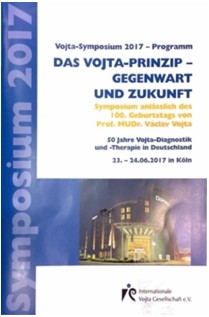2017年國際Vojta(輔以達)研討會
106年07月16日
2017年國際Vojta(輔以達)研討會
國際Vojta研討會於2017年6月23及24日於德國科隆舉行,這次研討會的主題訂為 「輔以達原則—現在和未來」 (das Vojta-prinzip – gegenwart und zukunft, the Vojta principle - present and future),此研討會還有另一個重要的意義為紀念 Dr. Vojta 100th 冥誕(Prof. Dr. Vaclav Vojta *1917.7.12- V2000.9.12),一般Vojta大會每2-3年舉辦一次,就如同大會手冊(圖一)上面德文所寫,這次除了是100年的紀念大會,這次大會舉辦的地點特別選在1971年Dr. Vojta第一次舉辦治療師課程的地方—科隆(Köln),也算是特別紀念Vojta在德國開始的起點。大會主題的內容,包含Vojta(輔以達)的理論背景、與其他科學領域相關的實務運用,內容非常廣泛。
很高興台灣Vojta(輔以達)學會有7位學員親臨現場,帶回最新的研究方向及內容,分成主題演講及工作坊二大部份 簡介如下:
|
|
|
|
德國科隆Dorint Hotel 舉行 |
2017 Vojta大會手冊 |
主題演講
主題一 :關於嬰幼兒腦性麻痺 (Infantile Cerebral palsy, ICP) 、早產兒-診斷與治療(Premature infants- Diagnosis and therapy)及呼吸疾患/ 纖維化囊腫—Vojta治療(Respiratory disorder/ Cystic fibrosis- Vojta therapy)
1. 使用Vojta原則—為動作障礙兒童發現和發展出診斷及治療的方法(The Vojta principle- Discovery and Development of a working method for the diagnosis and therapy of movement disorder )
2. 慕尼黑兒童中心對於診斷和治療腦性麻痺兒童的趨勢(Current trends in diagnostic and therapy of cerebral palsy at the children center Munich)
3. 早產兒追蹤至2歲的個案研究(Follow-up studies in highly immature premature infants Until the age of 2 )
4. 早產兒的輔以達治療(Vojta therapy in premature children)
5. 輔以達治療對於有呼吸問題的早產兒在避免肺支氣管發育不全的效用(Efficacy of Vojta therapy for the prevention of bronchopulmonary dysplasia in premature infants with respiratory syndrome)
6. 輔以達治療對於囊狀纖維化病人肺部功能的短期作用(Short-term effect of Vojta therapy on pulmonary function in patients with cystic fibrosis)
主題二:包含輔以達治療的神經生理基礎(Neurophysiological Basic)、評估(Apparative Evaluation)和輔以達治療的特殊的觀念(Special aspects of Vojta therapy)
1. 人類—演化的生物學雖然沒什麼特別,但確有某些特別的值得注意的地方(The human — evolutionary biology nothing special, but something very special)
2. 輔以達治療的觸覺刺激對於人類大腦產生的反應:神經影像學的研究(Mapping of the human brain with specific tactile input with Vojta therapy. A neuroimaging study)
3. 輔以達治療後腦部活動的改變 (Changes in brain activation after Vojta therapy)
4. 使用silicone hydrogel 的隱形眼鏡對於多重性障礙兒童的全面性的發展有顯著性的進步 (The optimal correction of the visual acuity by means of silicone hydrogel contact lenses leads to a significant progress in the overall psychomotor development in a multiple disabled child )
5. 輔以達治療是否會對成骨不全的病人造成危險? (Could Vojta Method be considered potentially dangerous in the treatment of osteogenesis imperfect? Recent developments on efficiency and safety of this technique )
主題三:包含應用行為學— 和互動面向Vojta(輔以達)原則和Vojta治療與行為治療的相關(Applied behavioral patterns - relationship to the Vojta principle / interaction in the Vojta therapy / behavioral therapeutic aspects )和Oncology腫瘤學
1. 原始反射的動力學與姿勢及動作型態的關聯The dynamics of Neonatal reactions (Primitive reflexes). Their networking with the posture and movement patterns
2. 使用Vojta(輔以達)治療時與父母溝通的重要Communication in Vojta therapy
3. 使用Vojta(輔以達)治療早產兒對自主神經系統的影響(understand and treat Preterm children in light of the specifics of their autonomic nervous system)
4. 在兒童急性或慢性血液腫瘤疾病(Acute and long term toxicity in pediatric hematoncology)
5. 使用Vojta (輔以達)治療在腫瘤兒童的經驗(Experiences with Vojta therapy in oncological children’s patients)
主題四:神經學復健 (Neurological Rehabilitation) 和測驗及結果(Examination and results)
1. 中風治療團隊以醫學和物理治療觀點治療急性中風病患 (Treatment of acute stroke on the stroke unit form a medical and physiotherapeutic point of view)
2. Vojta (輔以達)治療對於預防老年人跌倒的結果 (fall prevention in geriatrics through the use of Vojta therapy)
3. 脊髓損傷移行階段的信度及效度LOSSCI (Locomotor stages in Spinal Cord Injury)- The validity and relativity of a locomotion scale based on movement patterns. An new assessment in paraplegiology)
4. 脊髓損傷在使用Vojta (輔以達)治療對於行走能力的改變(The effect of the change in the ability to walk in patients with paraplegia after Vojta theray, determined by evidence-based walking tests)
5. Vojta (輔以達)治療用於肩關節夾擠症候群(Vojta therapy for subacromial syndrome)




